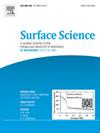异质结构Bi2S3/Ni3S2电催化水裂解性能的DFT研究
IF 1.8
4区 化学
Q3 CHEMISTRY, PHYSICAL
引用次数: 0
摘要
随着全球环境污染问题的日益严重,设计高效、经济的双功能电催化剂成为一个重要且极具价值的研究领域。利用密度泛函理论(DFT)研究了Bi2S3/Ni3S2异质结构对析氢反应(HER)和析氧反应(OER)的电催化性能。用催化剂表面氢原子吸附的吉布斯自由能变化量(|∆G* H|)评价HER的催化性能,用过电位(η)评价OER的催化性能。计算结果表明,Bi2S3/Ni3S2异质结构具有-0.098/0.85 V的过电位,优于Ni3S2的电催化性能,是一种很有前途的双功能电催化剂。通过对其电子结构和电荷转移行为的分析,表明催化性能的增强主要归功于Bi2S3/Ni3S2的异质结构,该异质结构具有较高的电导率,在价带最大值附近具有较高的态密度,并且对H2O的吸附更稳定。此外,还考察了杂质原子对Bi2S3/Ni3S2催化性能的影响。结果表明,在Ni3S2中掺杂Co提高了Bi2S3/Ni3S2异质结构的电催化性能。本文章由计算机程序翻译,如有差异,请以英文原文为准。

A DFT study on the electrocatalytic water splitting performance of heterostructure Bi2S3/Ni3S2
The global environmental pollution issue is becoming increasingly severe, making the design of efficient and cost-effective bifunctional electrocatalysts an important and highly valuable area of research. This paper investigates the electrocatalytic performance of the Bi2S3/Ni3S2 heterostructure for the hydrogen evolution reaction (HER) and oxygen evolution reaction (OER) using density functional theory (DFT). The catalytic performance for HER is evaluated by the change in Gibbs free energy of hydrogen atom adsorption on the catalyst surface (|∆G* H|), while the overpotential (η) is used to assess the catalytic performance for OER. The calculations reveal that the Bi2S3/Ni3S2 heterostructure exhibits a low overpotential of -0.098/0.85 V, outperforming the electrocatalytic performance of Ni3S2, making it a promising bifunctional electrocatalyst. By analyzing its electronic structure and charge transfer behavior, it is demonstrated that the enhanced catalytic performance is primarily attributed to the Bi2S3/Ni3S2 heterostructure, which contributes to high conductivity, a high density of states near the valence band maximum, and more stable H2O adsorption. Furthermore, the effect of impurity atoms on the catalytic performance of Bi2S3/Ni3S2 is examined. The results indicate that doping Co into Ni3S2 enhances the electrocatalytic performance of the Bi2S3/Ni3S2 heterostructure.
求助全文
通过发布文献求助,成功后即可免费获取论文全文。
去求助
来源期刊

Surface Science
化学-物理:凝聚态物理
CiteScore
3.30
自引率
5.30%
发文量
137
审稿时长
25 days
期刊介绍:
Surface Science is devoted to elucidating the fundamental aspects of chemistry and physics occurring at a wide range of surfaces and interfaces and to disseminating this knowledge fast. The journal welcomes a broad spectrum of topics, including but not limited to:
• model systems (e.g. in Ultra High Vacuum) under well-controlled reactive conditions
• nanoscale science and engineering, including manipulation of matter at the atomic/molecular scale and assembly phenomena
• reactivity of surfaces as related to various applied areas including heterogeneous catalysis, chemistry at electrified interfaces, and semiconductors functionalization
• phenomena at interfaces relevant to energy storage and conversion, and fuels production and utilization
• surface reactivity for environmental protection and pollution remediation
• interactions at surfaces of soft matter, including polymers and biomaterials.
Both experimental and theoretical work, including modeling, is within the scope of the journal. Work published in Surface Science reaches a wide readership, from chemistry and physics to biology and materials science and engineering, providing an excellent forum for cross-fertilization of ideas and broad dissemination of scientific discoveries.
 求助内容:
求助内容: 应助结果提醒方式:
应助结果提醒方式:


